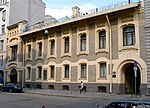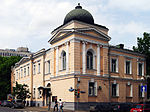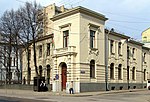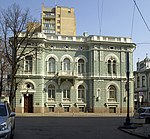Powarskaya Street

The Povarskaya Street ( Russian Поварская улица ), named 1923-1993 Worowskowo Street (Russian улица Воровского), is one of the oldest streets in Moscow . It is located in the center of Moscow in the Arbat and Presnensky districts of the Central Administrative District and leads from New Arbat Street to Kudrinskaya Square.
In the street there are outstanding Art Nouveau buildings that were built around 1900. Today, numerous embassies and the Russian Supreme Court reside on Powarskaya Street .
origin of the name
The street name goes back to the 16th century when the area was inhabited by cooks (Russian Powar ) and servants of the court kitchen. The surrounding streets were also named after court servants ( Chlebny baker , Skatertny tablecloth weaver , Stolovy carpenter , Noschovy, Tschaschnikow).
history
Powarskaya Street was built as part of what was then the Volotskaya Route from Moscow to Veliky Novgorod and led to the intersection of Volotskaya and Smolenskaya, where Arbatskaya Square is now. 1471 returned Ivan III. and in 1572 Ivan IV on the road from Veliky Novgorod back to Moscow. The Povarskaya sloboda was on the right side in the 17th century and was here until the 18th century. According to documents, 477 cooks and other service staff lived here in 1573. When Saint Petersburg became the new capital in 1712, the court with the court kitchen was transferred there. Then Powarskaya Street began to turn into an aristocratic district. The number of large landowners increased, and the smaller houses gradually disappeared. The first stone houses were built, as well as four churches. In 1716 princes PM Boryatinsky, LB Sibirsky, IM Gagarin, IA Galitzin, Princess Volkonskaya and Tsarevna Natalia Alexejewna - Peter I's sister - lived in the street. However, most of the residential buildings were made of wood. In 1775 around 90% of the stone structures were churches. All wooden buildings were destroyed in the fire in Moscow (1812) .
The construction of massive buildings did not begin until 1812. Some of these houses have survived to this day - Dolgorukov, Bludov, Sheremetyev, Gagarin houses. MJ Lermontov , DW Davydov and Pushkin's parents also lived here . Pushkin himself was often a guest in Powarskaya when he visited friends who lived there. In 1831 he read his poem Poltava here . In a travel guide for Moscow from 1831 it says: “No road is smoother and straighter than Powarskaya. It has no majestic buildings, but it is a very beautiful street ”.
At the end of the 19th century, Powarskaya Street was one of the first streets in Moscow to be planted with greenery. Linden trees were planted along the sidewalks in 1899 . Later houses were built according to the plans of well-known architects: for LN Kekuschew , PP Sikow, AN Seligson, NW Nikitin, AS Kamiski, WE Dubowski and others. In addition, a few tenement houses were built before the First World War. In 1914 Powarskaya had 54 houses, including six belonging to the church, four different organizations, 16 princes and counts, and 28 other well-known residents. In summer, the residents of the street often drove to their holiday homes , so the street seemed deserted.
In the 18th and 19th centuries, Powarskaya Street was one of the most aristocratic streets in Moscow. Representatives of many princely families lived here, for example from the houses of Dolgorukov , Galitzin , Sheremetev , Gagarin , Baryatinski or Volkonsky . At the beginning of the 20th century, houses were also built for business people (Morozow, Ryabuschinsky, Okhotnikow, Firsanow and others). The street is linked to the life and work of some significant figures in Russian culture. The writers MJ Lermontow , GR Derschawin , NP Ogarjow , PI Melnikow-Pechersky , IA Bunin , the actors WF Komissarschewskaja and AA Jablotschkina and the composers MM Ippolitow-Iwanow and NJ Mjaskowski lived here .
Fighting took place here during the 1905 Revolution and the October 1917 Revolution (1905 between government troops and the proletariat, 1917 between Bolsheviks and anarchists / Junkers).
Soviet period
After the October Revolution, Powarskaya Street was completely paved and street lamps were installed. In 1923 it was renamed Vorovskovo Street in memory of WW Vorovsky . A number of buildings were destroyed in the 1920s to 1930s. Some houses were rebuilt in the style of constructivism . During this time, the World Literature Institute and other literary organizations such as the Union of Writers of the USSR moved to Powarskajy. In the 1940s to 1950s, the building of the Supreme Court of the USSR, a residential building and the house of the Gnessin Institute were built. In the 1960s, buildings at the beginning of the street were demolished for the construction of New Arbat Street (Kalininski Project). As a result, Powarskaya Street lost the exit to Arbatskaya Square and was shortened.
Contemporary period
In 1994 Vorovskovo Street was renamed Powarskaya again. Today many buildings have "monument protection status". Here are the embassies of: Norway , Cyprus , Cameroon , Afghanistan , New Zealand , Germany and Hungary as well as a Lithuanian cultural center. There are monuments to LN Tolstoy , M. Gorky and IA Bunin . In addition, there was a natural monument here until 2010 , a 200-year-old elm, which, however, died during the extreme heat in summer 2010. At the beginning of the 21st century, two new buildings were added - a residential building and the Supreme Court complex.
Attractions
There are many striking or historically significant buildings on Powarskaya Street.
Page with odd house numbers
- The church of Simeon Stolpnik with the bell tower (No. 5, 4) was built by order of Tsar Fyodor Alexejewitsch 1676–1679 in the Russian architectural style Moscow usorochye (Russian: Московское узорочье ). She was visited by well-known people, including NW Gogol was a parishioner of the church from 1848 to 1852). KP Pobedonoszew , ST Aksakov and other celebrities were married here. The building was badly damaged during the fire of 1812. After 1938 the church was closed and the building was used by various organizations. Architects planned to demolish the church during the planning of Neue Arbat Street, but popular resistance saved the church. In 1991 it was returned to the Russian Orthodox Church.
- The residential house Grachyov (No. 7) was built in 1816 (according to other sources, 1820-1822). The first owner was the historian DI Nikiforov. Then NA Milyutinlived (and died) here, since 1873 the manufacturer MS Grachyov. The house was rebuilt in 1885–1887. The Norwegian embassy has been here since 1944. The government of Norway attaches great importance to the care and maintenance of this building and carries out renovations and restorations on a regular basis. According to the Ambassador of Norway, the house could compete with the Royal Palace in Oslo.
- The house Kazakow-Dunker-Zetlin (No. 9) was built in 1813 and rebuilt in 1892, the interiors were decorated with the support of MA Wrubel . In 1910 OS Zetlin bought the house for his son, a poet. Visited here were: WW Mayakovsky , MI Tsvetaeva , MA Voloshin , OE Mandelstam . In autumn 1917 Haus was besieged by the anarchists. The building was somewhat damaged in the course of the Bolshevik storm (April 12, 1918). The Embassy of Sudan has beenhere since 1950, andthe Embassy of Cyprus since 2004, after the restoration.
- The residential building PM Tschernow (No. 11) was built in the middle of the 18th century. Rebuilt after 1812 and in the 1870s. The writer PI Melnikow-Pechersky (1875–1876) and composer and conductor MM Ippolitow-Iwanow (1870s) lived here. NA Rimsky-Korsakov visited here, among others. Between 1900–1901 the renovation followed by increasing the number of floors, demolishing the wings and other building measures. After the October Revolution, officials lived and worked in the house. In 1918 JV Stalin , then People's Commissar for Nationality Issues ,also worked here. In 1932 two floors were built. From 1974 to 1991 the publishing house of Soviet writers was located here.
- The building of the Supreme Court (No. 13, 15) was the home of IJ Bludow. It was originally three-story. His relative GR Derschawin lived here from 1768–1780. MJ Lermontow lived here from 1829-1832 and Komissarschewskaja in the 1890s. In the 1880s, 1891–1893 and 1913 the house was expanded, and in 1913 a fourth floor was added. After the revolution, the Moscow Governorate Court worked here first, then the War College of the Supreme Court of the USSR. The following six-story building (No. 15) was built in 1956 on the site of the church, which was demolished in 1952, especially for the Supreme Court of the USSR.
- The residential building AI Nosenkow / WA Balin (No. 21/17) . In the middle of the 18th century there was a wooden house here. SL Pushkin, the father of AS Pushkin, lived here from 1807. NM Karamsin , PA Vyazemsky , KN Batjuschkow were here to visit. The businessman AI Nosenkow bought the house in 1887. He had it torn down and builta new buildingaccording to the plans of AS Kaminski . The last owner of this house before the October Revolution was businessman WA Balin. In 1920 here was the diplomatic mission Poland the message from 1936 to 1967 in Hungary , followed by various Hungarian organizations. A Hungarian cultural center has been located here since 1999.
- The Gagarin building (No. 25a) . The main house was built in Empire style from1820 to 1823according to plans by Domenico Gilardi (architect Joseph Bové was the planneruntil 1975). The building has no colonnades, as is often the case in the Empire style, instead round arched niches with columns in a Doric order . The first owner was SS Gagarin, after which the businessman Ochotnikow from Penza bought the house. From 1875, Pushkin's eldest daughter, Marija Alexandrovna,lived here. The building has been used by the World Literature Institute since 1937. A Gorky monument (sculptor VI Muchina ) has stood infront of the building since 1956.
Page with even house numbers
- The residential house M. Saarbekow (No. 24) was built in Art Nouveau 1899–1890 according to plans by the architects LN Kekuschew and SS Schuzman for the businessman M. Saarbekow. It is one of the oldest Art Nouveau buildings in Moscow. There used to be old wooden mansions on this property, where MJ Lermontow, for example, spent his childhood. The Lithuanian embassy has beenin this building since1920( LiSSR since 1940). The writer Antanas Venclova lived here for a time . Now the Lithuanian Cultural Center is located here.
- Building of the Gnessin Institute (No. 30/36, 32, 36-38) . No. 30/36 by WN Okhotnikow was built in 1832–1838. It originally had two parts of the building. The first owner was Major General KP Ofrosimov. In 1892 it was rebuilt according to plans by AS Kaminski. The building has been used by the Gnessin Institute since the 1950s. It is considered the elite music academy in Russia. Building no. 32 was built in 1937-1946 in socialist classicism on the site of the church from the end of the 17th century, which was demolished in 1936. The museum in honor of Jelena Gnessina , who founded the institute together with her sisters and headed it for 72 years, is also located here. The 13-story building No. 36–38 was built in 1974 on the site of AD Samarin's home that was demolished in 1965.
- The Ponisowski building (no. 42/1) was built in 1903 in Art Nouveau style according to plans by LN Kekuschew; In 1914–1915, the facades wereredesignedin a classical style . As a result, the house lost all the characteristics of Art Nouveau. The house has a groundbreaking construction for the beginning of the 20th century, as a predecessor of constructivism . The decor is also noteworthy, including personal items from Napoleon and paintings by famous artists. The embassy of Afghanistan has been located here since the 1920s.
- The residential building IA Mindowski (No. 44/2) is one of the outstanding Art Nouveau buildings in Moscow. It was built between 1903 and 1904, also according to the plans of LN Kekuschew, and bought by the manufacturer IA Mindowski between 1904 and 1909. Mindowski's children owned the house until the October Revolution. In 1924 the building washanded over to the Swedish diplomatic mission, after which it was used as the ambassador's residence until 1972. The New Zealand embassy and ambassadorresidence has been located here since 1972. Due to a major successful restoration of the building, the Embassy of New Zealand received an award from the Moscow government “For Respect for the Culture of Russia” (Russ. За уважение к культуре России ).
- The residential building JR Schlossberg (No. 46) - residence of the ambassador of Germany was built 1910–1911 according to the plans of the Polish architect AN Seeligson in the Renaissance style, who worked in the Russian Empire from 1907–1917. The interiors are designed in Art Nouveau, Empire and late Rococo styles. At the end of the 1920s, commercial and diplomatic missions of the British Empire were located here. The residence of the Ambassador of the Federal Republic of Germany has been located here since 1956.
- AN Volkonskaya house (No. 48) is the only surviving wooden house on Powarskaya Street. The one-story house with mezzanine was built in 1815 by an unknown architect. Similar buildings were typical of the Powarskaya in the first half of the 19th century. In 1858 the house belonged to KP Naryshkin. His friend Alexandre Dumas the Elder was here on the occasion of his trip to Russia. Here he enjoyed, according to his words, "royal hospitality". Next to it is a single building, also made of wood, built in 1802 andsurvived the Moscow fire (1812) .
Individual evidence
- ↑ Povarskaya Street on um.mos.ru (English)
- ↑ Interiors of the residence of the German Embassy, Powarskaya No. 46
Coordinates: 55 ° 45 ′ 20.4 " N , 37 ° 35 ′ 27" E



















